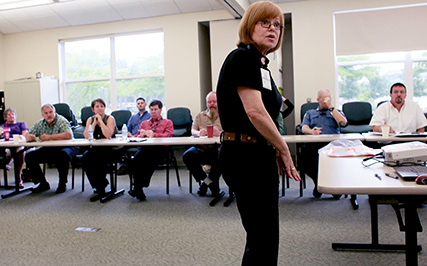Tribal Government & News
Emergency Management Advisory Council holds first meeting

"We're getting ready," said Alton Butler, Tribal Building Inspector, on his way in to the first meeting of the Tribe's Emergency Management Advisory Council held in the Education Department conference room on Wednesday, Sept. 17. "It could happen anytime."
The meeting was held in conjunction with September being National Preparedness Month.
Leaders of almost every Tribal department attended. Representatives from West Valley Hospital in Dallas; from Tacron, a local vendor that specializes in managing emergencies; from the local Nazarene Church; and from Yamhill County and the state participated.
To more than 20 people in attendance, Tribal Emergency Operations Coordinator Jamie Baxter said, "Our biggest catastrophic threat in the Grand Ronde area, and western Oregon, for that matter, is the Cascadia Subduction Zone earthquake fault that runs from British Columbia, along the Oregon coastline, to northern California."
In response, 19 stakeholders - from legislators to engineers to state department heads - created the 2013 Oregon Resilience Plan. Based on information collected by the Oregon Department of Geology and Mineral Industries, the plan estimates a 37-percent chance of a 9 to 9.5 magnitude earthquake in the next 50 years.
Hundreds of aftershocks occur following a subduction zone earthquake. Scientists predict most bridges and overpasses from British Columbia to northern California would come down. Interstate 5 would be impassible for months.
An older Oregon report estimated that an 8.5 Cascadia Subduction Zone earthquake would cause 12,700 injuries, 5,000 to 10,000 deaths, 17,300 displaced households and $12 billion in economic loss. Some consider these estimates as too conservative.
"There are a lot of fault lines in the area," Baxter said, "and some are still unknown. There will be people we don't know are in trouble."
In addition, there may be 2,000 people in Spirit Mountain Casino and many more children at area schools when an earthquake occurs.
In rural communities like Grand Ronde, help might not come for weeks or months.
"Survival will depend on preparedness," said Baxter. "You can't go back after the event. Catastrophic events do happen. We can and will be impacted; we just don't know when. Life is never the same after you are in a catastrophe."
Part of the preparation has got to be in everyone having emergency kits. "The basics are very important: food, water, toiletry and information," she said.
As an example, Baxter said, most people are not injured from a building falling, but from items falling from shelves or people sliding into things.
The emergency preparedness meeting and the ones to follow describe the steps it takes to create community, resilience and the kind of personal relationships that will keep the preparation and emergency processes working through communications made smoother by familiarity with emergency co-workers.
Tribal Reservations have a confusing mix of people and lands. "It is hard to write declarations so people in the community are treated the same. The Tribal perspective, though, is to help all," Baxter said.
Federal aid, though it seems remote from actual preparedness, is an important component. Reimbursement will only go to Tribal members and although documentation is difficult, reimbursement counts on it. Child care is a reimbursable expense, for instance. The Tribe pays 25 percent of the cost of personnel involved in the work, but volunteerism, for which the Tribe does not pay, can be included in that 25 percent to bring down the actual cost to the Tribe.
"I'd like to see the Tribe and Willamina schools planning together," Baxter said. "And I want to know how I can help all of you."
"What can we do to help?" asked Penny Edwards, co-chair of Emergency Management at West Valley Hospital. She said of the hospital's part, "We have 10 emergency beds and a good transferring process. We have a dedicated decontamination team and two trailers for mobile responses."
Melinda Seibert, the other co-chair at West Valley, added that its emergency team is training with ham radios.
"I'm not impressed with what is between the covers of three-ring binders," said Erik Rapp, Oregon Emergency Management planner. "I'd like to see training and outreach on a continual basis."
"As Jan (Looking Wolf Reibach) would say, 'We're all one people' in an emergency," Baxter said.
Through more meetings, the Tribe is coordinating training and exercises, creating the kind of "muscle memory" that will make "stop, drop and hold on to the table closest to you" automatic.
A check around the room found that not everybody understood their roles in an emergency. Making sure everybody knows their role is one of the purposes of the on-going series of meetings and trainings, Baxter added.
